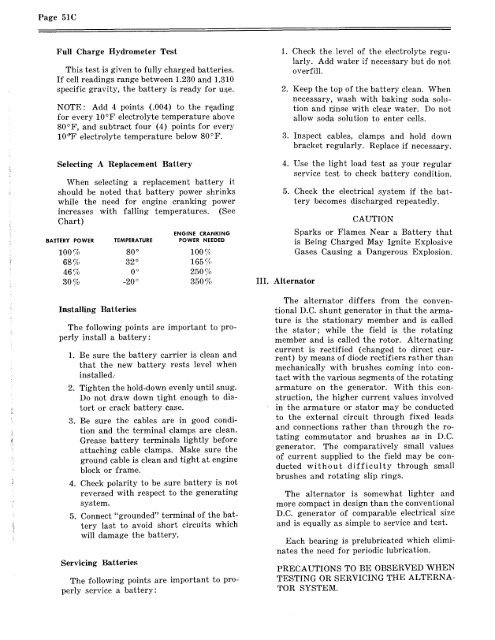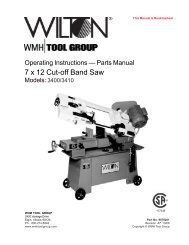Continental L-Head Overhaul Manual - Igor Chudov
Continental L-Head Overhaul Manual - Igor Chudov
Continental L-Head Overhaul Manual - Igor Chudov
You also want an ePaper? Increase the reach of your titles
YUMPU automatically turns print PDFs into web optimized ePapers that Google loves.
Page 51C<br />
Full Charge Hydrometer Test<br />
This test .is given to fully charged batteries.<br />
If cell readings range between 1.230 and 1.310<br />
specific gravity, the battery is ready for u~e.<br />
NOTE: Add 4 points (.004) to the re.ading<br />
for every 10°F electrolyte temperature above<br />
80°F, and subtract four (4) points for every<br />
10~F electrolyte temperature below 80°F.<br />
Selecting A Replacement Battery<br />
When selecting a replacement battery it<br />
should be noted that battery power shrinks<br />
while the need for engine cranking power<br />
increases<br />
Chart)<br />
with falling temperatures. (See<br />
ENGINE CRANKING<br />
BATTERY POWER TEMPERATURE POWER NEEDED<br />
100 % 80 o 100 ~<br />
68 % 32 o 165 %<br />
46% 0 ° 30% -20 °<br />
250%<br />
350%<br />
Installing Batteries<br />
The following points are important to properly<br />
install a battery:<br />
1. Be sure the battery carrier is clean and<br />
that the new battery rests level when<br />
installed..<br />
2. Tighten the hold-down evenly until snug.<br />
Do not draw down tight enough to distort<br />
or crack battery case.<br />
3. Be .sure the cables are in good condition<br />
and the terminal clamps are clean.<br />
Grease battery terminals lightly before<br />
attaching cable clamps. Make sure the<br />
ground cable is clean and tight at engine<br />
block or frame.<br />
4. Check polarity to be sure battery is not<br />
reversed with respect to the generating<br />
sy,stem.<br />
5. Connect "grounded" terminal of the battery<br />
last to avoid short circuits which<br />
will damage the battery.<br />
Servicing Batteries<br />
The following points are important to properly<br />
service a battery:<br />
III. Alternator<br />
o<br />
Check the level of the electrolyte regularly.<br />
Add water if necessary but do not<br />
overfill.<br />
Keep the top of the battery clean. When<br />
necessary, wash with baking soda solution<br />
and r.inse with clear water. Do not<br />
allow soda solution to enter cells.<br />
Inspect cables, clamps and hold down<br />
bracket regularly. Replace if necessary.<br />
Use the light load test as your regular<br />
service test to check battery condition.<br />
Check the electrical system if the battery<br />
becomes discharged repeatedly.<br />
CAUTION<br />
Sparks or Flames Near a Battery that<br />
is Being Charged May Ignite Explosive<br />
Gases Causing a Dangerous Explosion.<br />
The alternator differs from the conventional<br />
D.C. shunt generator in that the armature<br />
is the stationary member and is called<br />
the stator; while the field is the rotating<br />
member and is called the rotor. Alternating<br />
current is rectified (changed to direct current)<br />
by means of diode rectifiers rather than<br />
mechanically with brushes coming into contact<br />
with the various segments of the rotating<br />
armature on the generator. With this construction,<br />
the higher current values involved<br />
in the armature or stator may be conducted<br />
to the external circuit through fixed leads<br />
and connections rather than through the rotating<br />
commutator and brushes as in D.C.<br />
generator. The comparatively small values<br />
of current supplied to the field may be conducted<br />
without difficulty through small<br />
brushes and rotating slip rings.<br />
The alternator is somewhat lighter and<br />
more cbmpact in design than the conventional<br />
D.C. generator of comparable electrical size<br />
and is equally as simple to service and test.<br />
Each bearing is prelubricated which eliminates<br />
the need for periodic lubrication.<br />
PRECAUTIONS TO BE OBSERVED WHEN<br />
TESTING OR SERVICING THE ALTERNA-<br />
TOR SYSTEM.
















